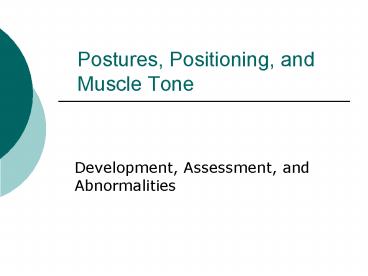Postures, Positioning, and Muscle Tone PowerPoint PPT Presentation
1 / 17
Title: Postures, Positioning, and Muscle Tone
1
Postures, Positioning, and Muscle Tone
- Development, Assessment, and Abnormalities
2
Participation
- Physical Disability and Participation
- Physical disability can negatively affect a
students participation in curricular, extra
curricular, and major life activities - Two Types of Important Information -
- Circumstances that give children difficulty
when they try to participate - Modifications that might present helpful
solutions
3
Postures
- Positioning to provide the physical foundation
for participation in functional activities in
school and other life activities - Mobility for moving from place to place to
participate as fully as possible in major life
activities
4
Positioning
- The need varies depending on age, disability, and
intended use - Proximal Support of Body
- Affective use of Upper Body
- Security and Safety
- Reduction of Deformity
- Frequency of Change
- Seating
- Posture and Muscle Tone
5
Seating
- Directly influences posture, muscle tone, and
coordination - Pelvic Position
- Foot Support
- Shoulder/upper Trunk Support if needed
- Inadequate Positions
- Devices
6
Postures
- Relationship to appearance and socialization
- Studies on appearance
- Awareness
- Postures Plural (Rathbone, 1965)
- Good postures equal a balance of Strength and
Flexibility - Gravity
- Anti gravity muscles
7
Postures Assessment
- Alignment
- Minimizing muscle imbalance
- Spinal column curves
- C 1-7 concave
- T 1-12 convex
- L 1-5 concave
- S 1-5 convex
- Analysis of muscle imbalance
- Questions
- too tight?
- too loose?
- role of gravity?
- Reciprocal Innervation
8
Normal Postural Development
- Single C - curve at birth
- 4 to 5 months Cervical curve
- When extensors of the neck and back are
strengthened by head lifting - 12 to 16 months Lumbar curve
- When extensors of the lower back are strengthened
by walking - Lordosis - week abs/tight hip flexors
9
Posture Training Guidelines
- Brief History
- For years individual prescribed exercises were
the accepted practice in posture training and
body mechanics - Boring
- Not effective if not adhered to
- Incorrect movements could cause injury
- Todays Trend
- Game like activities that utilize muscle groups
in therapeutically sound ways - Class activity to come up with activities
- Contraindicated Activities
- Straight leg lift/hold
- Straight leg sit ups
- Push ups
- Squats
10
Postural Abnormalities
- Functional or Structural?
- Forward Head and Neck
- When earlobe is not in alignment with tip of
shoulder (acromion process) - Ameliorative exercises
- Contraindications
- Excessive Head Tilt
- RT or LT
- Ameliorative Exercises
11
Postural Abnormalities
- Kyphosis - (Humpback, Hunchback, or Potts
curvature or rounded upper back) - Ameliorative Exercises
- Contraindications
- Lordosis - (Swayback or Hollow back)
- Ameliorative Exercises
- Contraindications
- Abdominal Weakness
- Low ab
- Upper ab
- Visceroptosis
- Ameliorative Exercises
- Contraindications
12
Postural Abnormalities
- Scoliosis lateral curvature of the spine
- Begins with single curve (primary) then a
compensatory curve in opposite direction - Keynote positions are diagnostic devices or
corrective exercises specifically for scoliosis - 1. Adams position
- 2. Hanging position
- 3. Standing position
- Ameliorative Exercises
- Uneven Shoulders/Hips
- May be normal unless scoliosis
- Left H or Right H
13
Balance and Postural Control
- Four main etiologies of balance and postural
control deficiencies - Central Sensory Impairments
- Central Motor Impairments
- Peripheral Sensory Impairments
- Peripheral Motor Impairments
14
Balance and Postural Control
- What can be done?
- Depends on.
- Suggestions
- Determine etiology and intervene
- Firm surfaces to move on / practice or training
on soft surfaces (if somatosensory) - Increase in room illumination (if visual)
- Strength training/Range of motion activities (if
peripheral motor)
15
Falls
- Factors -
- Tripping over hazardous objects (peripheral
motor) - Improper vestibular system (peripheral sensory)
- Slower RT to catch balance (central motor)
- Uneven surfaces (central or peripheral motor)
16
Gaits
- Characteristics of Older Adult
- Decreased walking speed
- Decreased stride length
- Increased double support period
- Reduction in toe-floor clearance
17
Gait Analysis
- Scissors Gait
- Hemiplegic Gait
- Ataxic / Cerebellar gait
- Shuffling gait
- Festination gait
- Steppage gait
- Waddling gait
- Muscular Dystrophy gait

